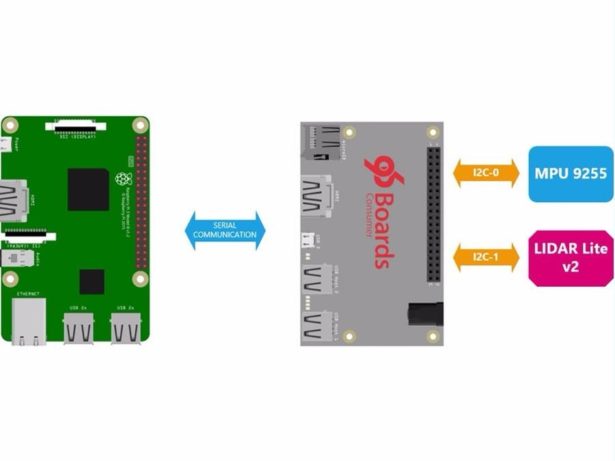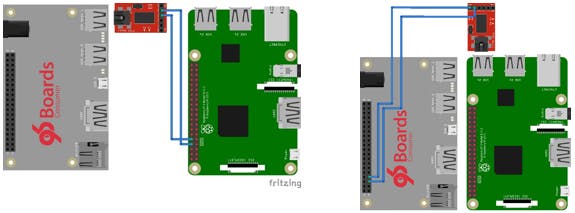Introduction
Communication plays an important role in distributed applications. It allows devices in a system to communicate with each other in order to exchange information or coordinate to perform some tasks. Depending on the communication requirements of the application such as wired / wireless, short distances / long distances, data transfer rates, security etc., suitable communication methods can be selected. In this work, Serial communication (RS-232 protocol) is chosen to demonstrate its application through the following examples. (The examples are broken down into their own links for easy access)
EXAMPLE 2 demonstrates a collaboration of DragonBoard (or Raspberry Pi) and Arduino (Nano or Due) to control a 2-DOF Pan and Tilt mechanism using servo motors. The DragonBoard directs the movement of the Pan and Tilt mechanism by sending the control commands to the Arduino via Serial communication. The Arduino will process the commands and control the servo motors. Interrupt technique is also applied between the DragonBoard and Arduino to enhance the coordination.
EXAMPLE 3 demonstrates application of using Serial communication in transferring data between an IoT device and a computer. The DragonBoard requests measurements of temperature and humidity from the SHT21 sensor, packs these measurement data into data packages and then sends them to the computer. A LabVIEW application in the computer will receive these data packages and extract the temperature and humidity measurements.
EXAMPLE 4 introduces an application of using DragonBoard/ Raspberry Pi to get updated GPS information (Global Positioning System) from a Ublox Neo-M8N GPS Module. Basically, the Ublox GPS Module transmits NMEA messages carrying GPS satellite information via Serial communication to the DragonBoard/ Raspberry Pi. An algorithm is designed to filter the received NMEA messages and extract selected information such as GPS Latitude, Longitude and UTC Time.
Serial communication using RS-232 Protocol
Serial communication using the RS-232 protocol is one of the common communication methods. It is a wire-based communication that allows a direct connection between two devices. In a simple connection, the RX pin (Receiver) on one side is connected to the TX pin (Transmitter) on the other side. The UART (universal asynchronous receiver/transmitter) interface is the hardware that implements this Serial communication. However, the disadvantage is this hardware interface only allows two devices to communicate with one another. Moreover, the distance and the data transfer rate are limited.
Technically, DragonBoard 410c and Raspberry Pi 3 can directly communicate with each other via their UART hardware. However, personal testing showed that the direct connection between the DragonBoard 410c and Raspberry Pi (2/3) is unstable because the DragonBoard 410c is designed to operate at low logic level (1.8V).
To enable the computer to communicate with the DragonBoard 410c or Raspberry Pi, UART hardware must also be supported on the computer. However, new generation computers do not have built-in UART hardware on the mainboard.
To solve those problems, a USB to TTL Serial Adapter module might be a solution. In fact, this module integrates a popular FT232RL chip which is a USB to serial UART interface. Using this module enables a UART hardware interface available on a USB port. In addition, this module allows a baud rate of 1 Mbps can be reached on the Serial communication.
Using USB-TTL Serial Adapter
There are two options of using the USB-TTL Serial Adapter for the communication between DragonBoard and Raspberry Pi. The first option is to connect the TX and RX pins of the DragonBoard to the TX and RX pins on the header of the USB-TTL Serial Adapter respectively. Then the USB (Type-B) port of USB-TTL Serial adapter and the USB (Type A) port of the Raspberry Pi is hooked up together. Using the same manner for the second option but the Raspberry Pi is swapped for the DragonBoard.
For the computer, the USB (Type B) port of the USB-TTL Serial adapter is connected to the USB (Type A) port on the computer panel. The TX and RX pins on the USB-TTL Serial Adapter header are connected to the corresponding TX and RX pins on the DragonBoard or Raspberry Pi.
For more detail: Using Serial Communication (RS-232 protocol) – Example 1


